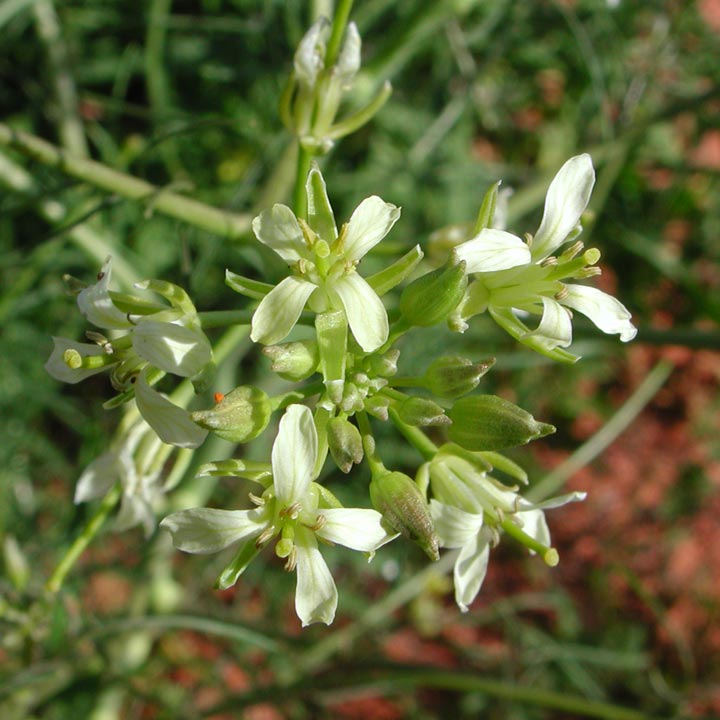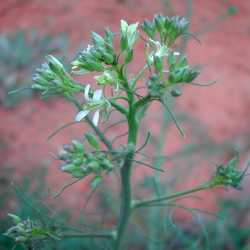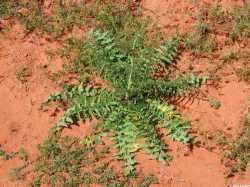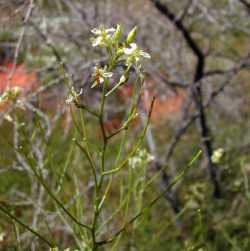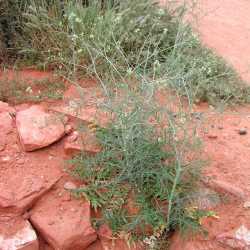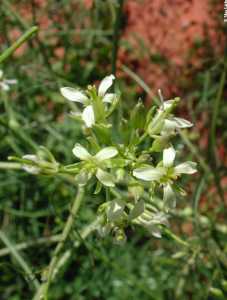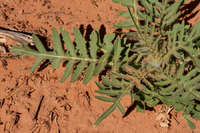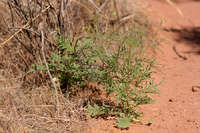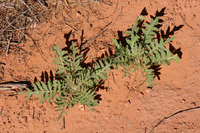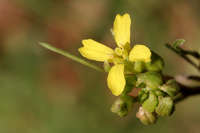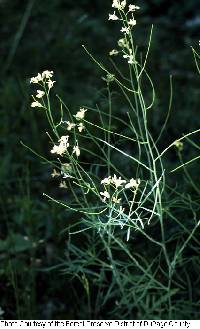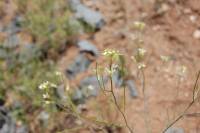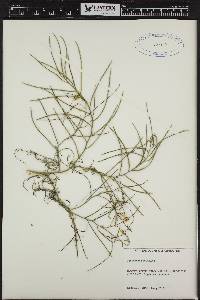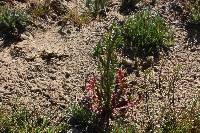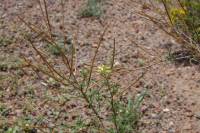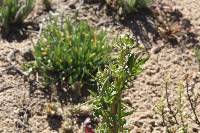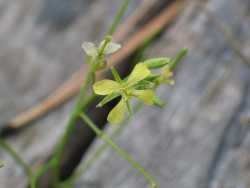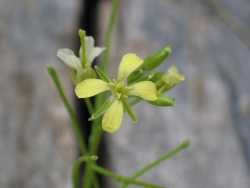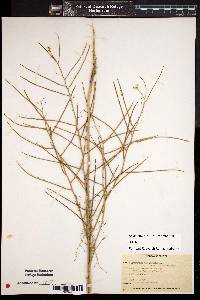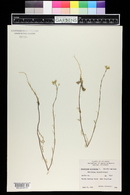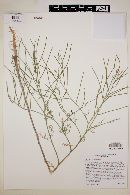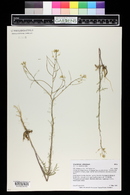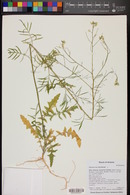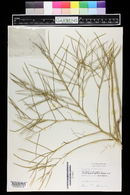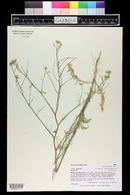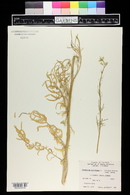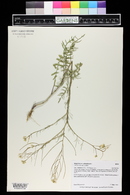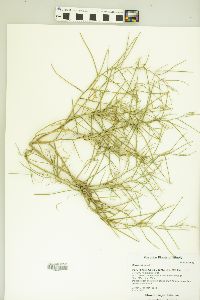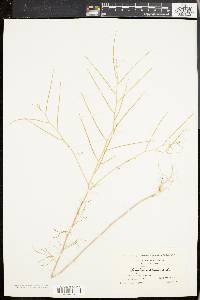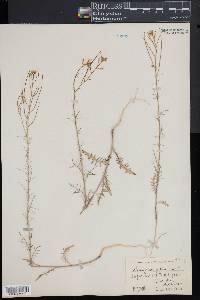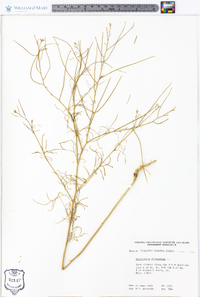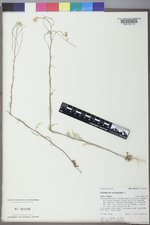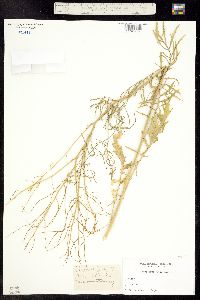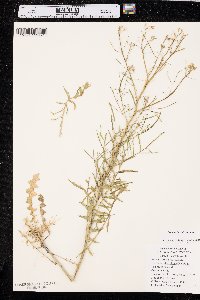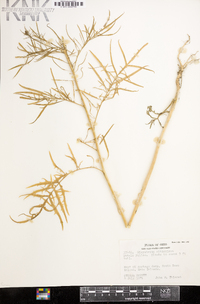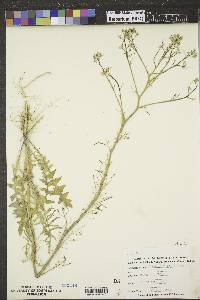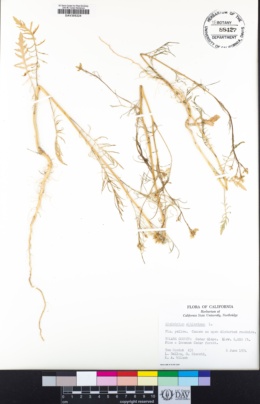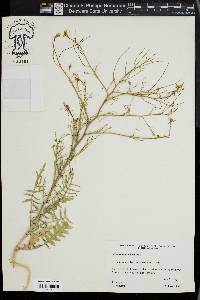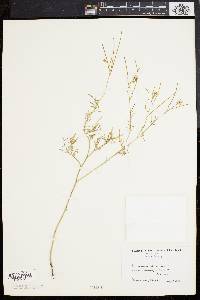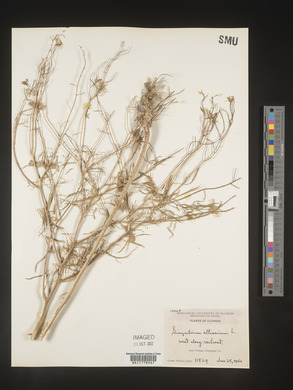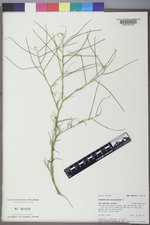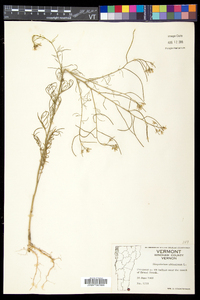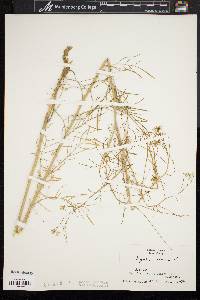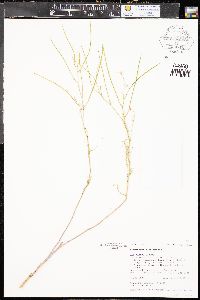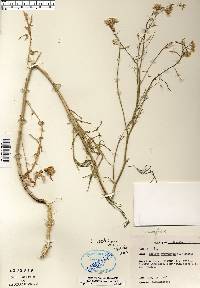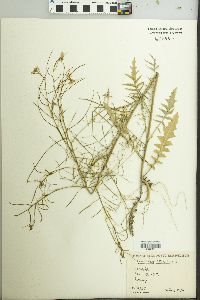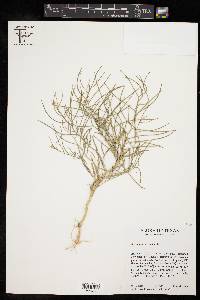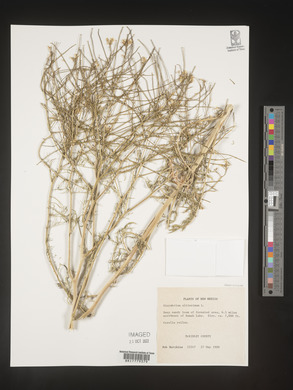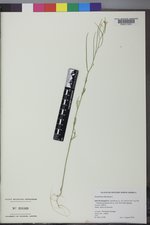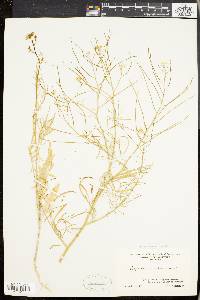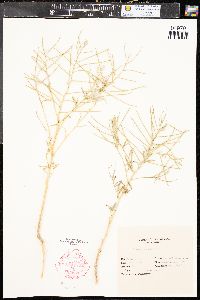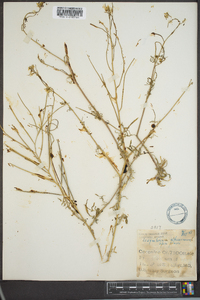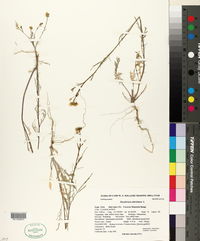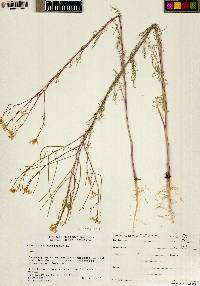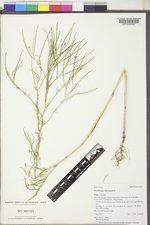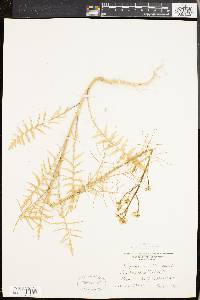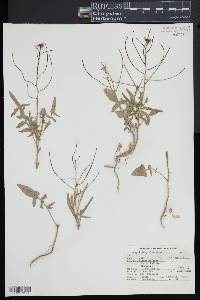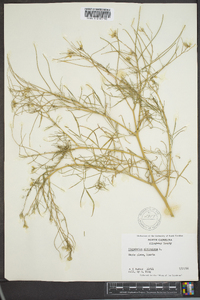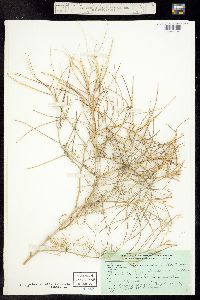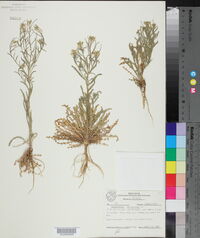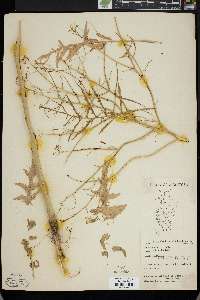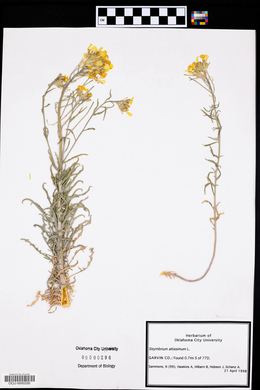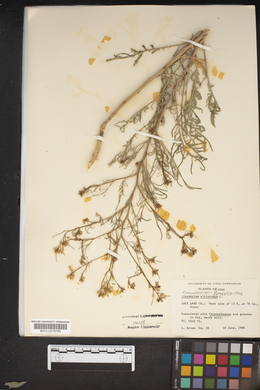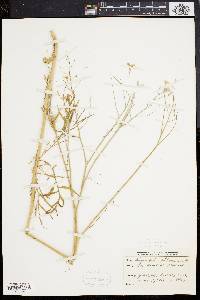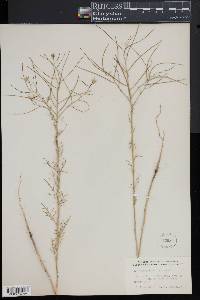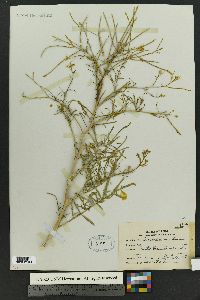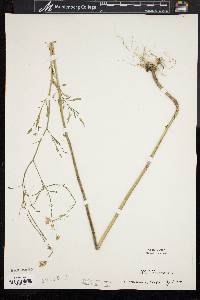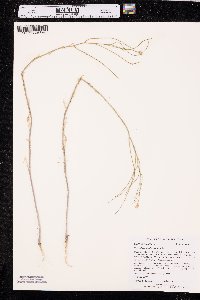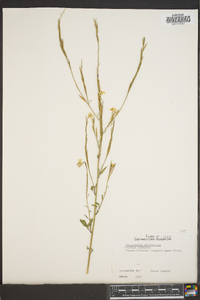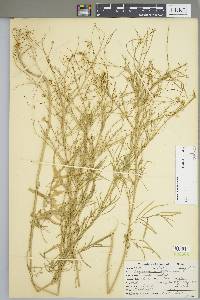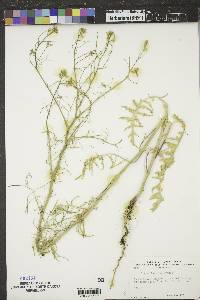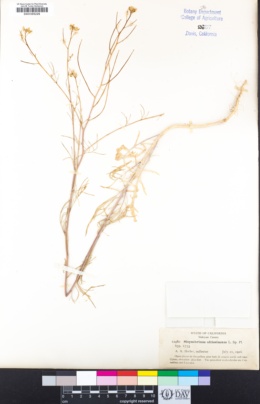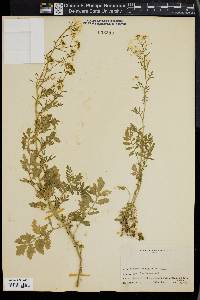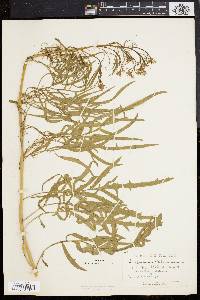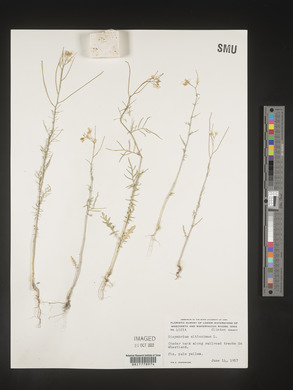Sisymbrium altissimum
|
|
|
|
Family: Brassicaceae
Tall Hedge-Mustard, more...tall tumblemustard, tumblemustard, Jim Hill mustard, tall mustard, tumble mustard, tumbleweed mustard
[Norta altissima (L.) Britt., moreSisymbrium pannonicum Jacq.] |
Annuals; glabrous or pubescent. Stems erect, branched distally, (2-)4-12(-16) dm, sparsely to densely hirsute basally, glabrous or glabrate distally. Basal leaves rosulate; petiole 1-10(-15) cm; blade broadly oblanceolate, oblong, or lanceolate (in outline), (2-)5-20(-35) cm × (10-)20-80(-100) mm, margins pinnatisect, pinnatifid, or runcinate; lobes (3-)4-6(-8) on each side, oblong or lanceolate, smaller than terminal lobe, margins entire, dentate, or lobed. Cauline leaves similar to basal; distalmost blade with linear to filiform lobes. Fruiting pedicels usually divaricate, rarely ascending, stout, nearly as wide as fruit, (4-)6-10(-13) mm. Flowers: sepals ascending or spreading, oblong, (cucullate), 4-6 × 1-2 mm; petals spatulate, (5-)6-8(-10) × 2.5-4 mm, claw 3.5-6 mm; filaments 2-6 mm; anthers oblong, 1.5-2.2 mm. Fruits narrowly linear, usually straight, smooth, stout, (4.5-)6-9(-12) cm × 1-2 mm; valves glabrous; ovules 90-120 per ovary; style 0.5-2 mm; stigma prominently 2-lobed. Seeds 0.8-1 × 0.5-0.6 mm. 2n = 14. Flowering Apr-Sep. Roadsides, fields, pastures, waste grounds, disturbed sites, grasslands; 0-2700 m; introduced; Greenland; Alta., B.C., Man., N.B., Nfld. and Labr. (Nfld.), N.W.T., N.S., Ont., P.E.I., Que., Sask., Yukon; Alaska, Ariz., Calif., Colo., Conn., D.C., Fla., Idaho, Ill., Ind., Iowa, Kans., Maine, Md., Mass., Mich., Minn., Mo., Mont., Nebr., Nev., N.H., N.J., N.Mex., N.Y., N.C., N.Dak., Ohio, Okla., Oreg., Pa., R.I., S.Dak., Tenn., Tex., Utah, Vt., Va., Wash., W.Va., Wis., Wyo.; Europe; w Asia; nw Africa; introduced also in South America (Argentina, Chile). Annual herb with a large taproot to 1 m tall Stem: upright, usually branched near the apex, sometimes purplish at the nodes, hairy on the basal one-fourth, and with a waxy coating (glaucous) above. Flowers: in compact, branched clusters (racemes), which are borne terminally and laterally on the stems. Racemes about 15 cm long. Flower stalks 7 - 8 mm long. Sepals four, upright to spreading, green, 5 - 6 mm long, 1.3 mm wide, linear, tips rounded, involute (rolled inward along the margins above). Petals four, exserted, spreading in the apical half, pale yellow, to 1 cm long, 2 - 3 mm wide at apex, spoon-shaped, bases narrowed, tips rounded. Stamens six, upright. Fruit: a long, narrow pod (silique), ascending to upright, stalks thick (nearly as thick as pods), 5 - 10 cm long, 1 - 1.5 mm wide, angled, sickle-shaped, on stalks to 1 cm long. Lower leaves: alternate, pinnately divided, stalked (purplish at base), leaf axes sparsely hairy. Segments five to eight pairs, 1 - 1.5 cm long, about 5 mm wide, awl- to lance-shaped, tips pointed, sometimes coarsely toothed and often involute (rolled inward along the margins above), shortly hairy. Terminal segments wider than the laterals and involute. Upper leaves: alternate, pinnately divided, stalked, small, leaf axes sometimes sparsely short-hairy. Segments fewer than lower leaves, about 2.5 cm long, about 1 mm wide, linear, bases often with smaller divisions, pointed at the tip, involute (rolled inward along the margins above). Similar species: No information at this time. Flowering: mid-May to mid-October Habitat and ecology: Introduced from Eurasia. Frequent on railroad ballast. It also grows in waste ground and recently disturbed sandy soils. Occurence in the Chicago region: non-native Etymology: Sisymbrium is the Ancient Greek name for various plants. Altissimum means very tall; tallest. Author: The Morton Arboretum ERI 2003, Kearney and Peebles 1969, USDA FEIS accessed 2015, FNA Duration: Annual Nativity: Non-Native Lifeform: Forb/Herb General: Weedy annual herb with stems 30-150 cm tall, generally highly branched, hirsute up to the inflorescence. Leaves: Basal leaves petioled, 7-15 cm long, deeply pinnately lobed with lanceolate segments. Stem leaves alternate, gradually reduced, petioled, deeply pinnately lobed with linear segments near top. Flowers: Raceme with sepals 4-5 mm long, outer two with erect horns, petals 5-9 mm long, pale yellow to nearly white. Fruits: Spreading siliques, linear and cylindric, 5-10 cm long, about 1 mm wide, branch-like. Ecology: Found in disturbed sites from 3,000-8,000 ft (914-2438 m); flowers April-September. Distribution: Native to Eurasia and natualized throughout most of the US and Canada. Also occurs in Africa and South America. Notes: This annual weed is distinguished by large, deeply pinnately lobed basal leaves and very narrow, delicate leaves on the upper part of the stem; long, narrow fruits that are only about as wide as their pedicels (fruiting stalks); and pale, cream or white colored flowers. S. irio is common annual weed in the genus; it has yellow flowers, is not as tall, with a maximum height of about 0.7 m, and the cauline leaves are the same size and shape as the basal leaves, or only a little reduced in size. S. linifolium also has yellow flowers, generally is not taller than 0.7m, and has much smaller leaves than S. altissima. Ethnobotany: Used as an emetic and the seeds were eaten in a porridge. Etymology: Sisymbrium is from a Greek name for some plants of the mustard family, while altissimum means very tall, or tallest. Synonyms: Norta altissima Editor: SBuckley, 2010; AHazelton 2015 Erect, to 1 m, commonly simple below and much-branched above, glabrous or sparsely pilose; lvs petioled, pinnatifid, the lower with 5-8 pairs of linear and entire to lanceolate and serrate segments, the upper small, with fewer segments; pet pale yellow, 6-8 mm; pedicels nearly or quite as thick as the fr, ascending, 5-10 mm; frs ascending or spreading, slender, 5-10 cm נ1-1.5 mm; 2n=14. Native of Eurasia, established as a weed of fields and waste places throughout most of the U.S. and adj. Can., especially northward. June-Aug. (Norta a.) Gleason, Henry A. & Cronquist, Arthur J. 1991. Manual of vascular plants of northeastern United States and adjacent Canada. lxxv + 910 pp. ©The New York Botanical Garden. All rights reserved. Used by permission. From Flora of Indiana (1940) by Charles C. Deam This is a weed generally of very sandy soil and is found most often in sandy ballast along railroads. It is also found along roadsides and in waste places and fallow fields where it is sometimes abundant, especially in the sandy area of the northwestern part of the state, where it sometimes covers acres. …… Indiana Coefficient of Conservatism: C = null, non-native Wetland Indicator Status: FACU |
|
|
|

